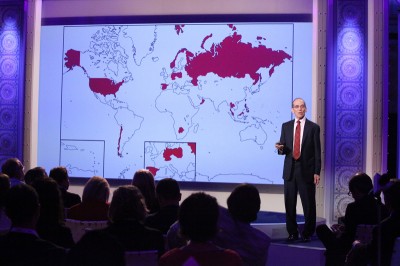The United States has some of the best university-based math teacher training programs in the world. But we also have some of the worst – and those poor performing programs produce 60 percent of the country’s teachers in schools with the highest percentage of students living in poverty, according to research released earlier this month from William Schmidt, co-director of the Education Policy Center at Michigan State University. The United States was the only country in his study to have such a wide range of performance by math teachers in teacher preparation programs.

Caption: William Schmidt of Michigan State University presented his research at this year’s Education Nation conference in New York City. (Photo: Rob Kim/NBC)
Improving teacher quality has emerged as a key strategy to increasing America’s global competitiveness, but teacher preparation programs are often criticized for being too easy to get into and too easy to complete. Schmidt’s research argues that the programs also aren’t teaching what they need to be.
Schmidt used data from the 2012 Teacher Education and Development Study-Mathematics, which surveyed, interviewed and tested elementary and middle school math teachers from 900 teacher prep programs in 17 countries on their content and pedagogical knowledge, and conducted his own survey of 2,000 randomly selected American teachers to figure out the courses taken by the top-scoring teachers. He concluded there are nine important courses for math teachers-to-be to take (such as observation, analysis and reflection on mathematical teaching and multivariate calculus, for instance), but only a third of U.S. middle school teachers who participated in the study had enrolled in at least eight of them.
When Schmidt followed up with these teachers two years later, he found that they were teaching in high-poverty schools.
“Our very worst programs produce over half of middle school teachers,” he said at Education Nation, NBC’s annual summit on the state of education in the United States. “Where they’re going is where the good teachers are mostly needed. “
Schmidt’s findings back up other criticism of teacher preparation programs. The National Council on Teacher Quality, a nonprofit advocacy group that has called for drastic improvements in teacher training, released teacher preparation programs ratings this spring in which they found the overall quality was dismal. The council’s methodology was questioned, though; their ratings were solely based on inputs, such as course syllabi, and did not consider how graduates fared in the classroom.
Schmidt’s research has not been controversial. While he did not use student test scores to evaluate teachers’ effectiveness, Schmidt said his research attempted to look at some outcomes of preparation programs. The test from the international study demonstrated their mathl knowledge and the follow-up surveys indicated their comfort levels with teaching certain math concepts.
The study also doesn’t aim to prove which teaching techniques are most effective, Schmidt said. Rather, it’s an attempt to compare American math teachers’ understanding of their subject to other countries, particularly those where students outperform the U.S.
“It certainly gives us good information that we know that this is what the top programs are doing and that this is what they’re teaching,” he said in an interview. “It would be like a yardstick, a measure that programs could look up against and say are we doing something close to this or not.”



